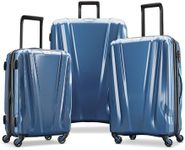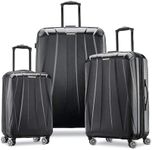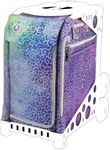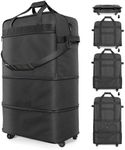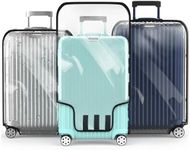Buying Guide for the Best Hard Shell Lightweight Suitcase
Choosing the right hard-shell lightweight suitcase can make your travel experience much more convenient and enjoyable. The key is to find a balance between durability, weight, size, and features that suit your specific travel needs. Here are some important specifications to consider when selecting a hard-shell lightweight suitcase.MaterialThe material of the suitcase is crucial as it determines the durability and weight. Common materials include polycarbonate, ABS, and aluminum. Polycarbonate is lightweight and highly durable, making it a popular choice. ABS is more affordable but slightly less durable. Aluminum is very strong but can be heavier. Choose a material that offers a good balance between weight and durability based on your travel frequency and handling.
WeightThe weight of the suitcase is important because it affects how much you can pack without exceeding airline weight limits. Lightweight suitcases typically weigh between 5 to 8 pounds. If you travel often and need to pack a lot, opt for a suitcase on the lighter end of the spectrum. For occasional travelers, a slightly heavier suitcase might be acceptable if it offers other benefits like extra durability or features.
SizeSuitcase size is measured in liters or by dimensions (height, width, depth). Common sizes include carry-on (20-22 inches), medium (24-26 inches), and large (28-30 inches). Choose a size based on the length and type of your trips. For short trips or carry-on only travel, a smaller suitcase is ideal. For longer trips or if you need to pack more items, a medium or large suitcase will be more suitable.
WheelsSuitcases come with either two wheels or four spinner wheels. Two-wheel suitcases are easier to pull over rough surfaces, while four-wheel spinners offer better maneuverability and can be pushed or pulled in any direction. If you often navigate through crowded airports or city streets, four-wheel spinners might be more convenient. For rougher terrain, two-wheel suitcases could be a better choice.
HandlesHandles should be sturdy and comfortable to grip. Look for telescoping handles that can be adjusted to different heights. Some suitcases also have side and bottom handles for easier lifting. If you have back issues or need to lift your suitcase frequently, ensure the handles are ergonomically designed and well-padded.
LocksSecurity is important, so consider suitcases with built-in TSA-approved locks. These locks allow TSA agents to open your suitcase for inspection without damaging it. If you travel internationally or through airports with strict security, a suitcase with a TSA-approved lock is highly recommended.
Compartments and OrganizationInternal compartments and pockets help keep your belongings organized. Look for suitcases with multiple compartments, zippered sections, and compression straps. If you like to keep your items neatly separated, choose a suitcase with a well-designed interior. For those who prefer a more open packing space, fewer compartments might be better.
ExpandabilitySome suitcases come with expandable sections that allow you to increase packing capacity. This feature is useful if you tend to bring back more items than you left with. If you often find yourself needing extra space, an expandable suitcase can provide the flexibility you need.







